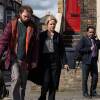As Season 4 of Grantchester hits it's halfway point, we've been impressed with the glimpse this season is giving us into the changing face of 1950s England. This season has been a whirlwind – and as momentous as the story line and character changes have been, we feel that nothing has truly compared to the changes in the British political climate.
The first episode of this season focused around the visit of Reverend Nathaniel Todd, an American civil rights activist visiting Grantchester to give a speech on the Civil Rights Movement. This event not only pushes forward the episode, but also reflects the practice of American civil rights activists encouraging the Black Power movement just beginning to flourish in the United Kingdom at the time. In the spirit of this episode, we have compiled a list of facts about the Black Power movement in the United Kingdom – an often underrepresented topic in the discussion of the civil rights movement.
1. After World War II, the United Kingdom saw an increase in immigrants from Africa and the Caribbean from former British colonies. Despite being welcomed by the British Nationality Act of 1948, these new immigrants faced discrimination and racially motivated violence upon arrival into the United Kingdom.
2. In late August of 1958, a group of white young men attacked Caribbean owned businesses and immigrants living in North Kensington, in an event that would later be called the 'Notting Hill Riots.' The violence continued until September 8th, 1958, yet the police declined to state that the riots had been racially motivated.
3. The civil rights movement in the United Kingdom continued to be spurred on by the protests and boycott taking place in the United States. Between 1964 and 1967, England hosted speeches by many prominent American Civil Rights activists, such as Martin Luther King, Malcolm X, and Stokley Carmichael.
4. These speeches, and the Civil Rights Movement in the United States, inspired many people of color to organize the British Black Power movement, which lasted from 1968 to 1971. The speech by Stockley Carmichael – which encouraged listeners to see themselves not as a member of a specific economic class or a minority within their country, but rather as a part of a global majority – in particular as been cited as inspiring many young activists at the time.
5. The British Black Power movement was devoted to educating British people of color about Black British history and filling the gaps left by the public education system, which usually only focused on the accomplishments of white Europeans. Through their protests and educational efforts, the British Black Power Movement was able to bring more attention to individual racism in the United Kingdom, as well as racism on the structural levels in the schools and the government.
6. One of the leaders of the British Black Power movement was Darcus Howe, an immigrant from Trinidad who worked to combat that housing and job discrimination he and many other immigrants faced upon moving to England. Howe gained national attention as a member of the "Mangrove Nine" and as being the leading organizer behind the Black People's Day of Action of 1981.
7. The 1960’s saw an increase in discriminatory legislation that sought to eliminate citizens' of the former territories of the British empire right to remain in the U.K – unless they had lived or worked there for five years. In particular, The Commonwealth Immigrants Act of 1968 denied immigrants from the former British colonies their automatic right to enter unless they had a parent or grandparent born in the United Kingdom.
8. In 1970, nine black activists, later dubbed the "Mangrove Nine," were arrested during a protest against continuous police raids of the Mangrove, a restaurant in Notting Hill that was popular among the area’s West Indian community. Howe demanded that they stand trial in front of an all-black jury, who would have a better understanding of the existence of police brutality than an all-white one. Although the concept was dismissed by the judge, the nine were able to dismiss jurors who did not have a correct understanding of the black power movement and police discrimination, and eventually were found not guilty of inciting a riot.
9. The year 1981 saw the Black People’s Day of Action, a march to protest the murder of 13 black teenagers in a house fire in New House that the protesters argued was improperly investigated by the police. The protest had over 20,000 protesters, and brought the Black Power Movement to the forefront of British news.
10. Today, historians fight to keep the memory of the British Black Power movement, and the advancements that it brought with it, alive. In 2010, the United Kingdom's government signed the Equality Act of 2010, which brought together 116 separate pieces of legislation into one act to make it illegal to discriminate against a person in the workplace – and outside of it – on the basis of race, gender, sexual orientation, religion and a host of other characteristics. That being said, in 2017 The Lammy Review – an independent study of the treatment of Black, ethnic minority, and Asian individuals in the criminal justice system in the United Kingdom – found that people of color make up 12% of the prison population in Wales and England, even though they make up 3% of the population in these areas. In addition to this, there was a 29% increase in hate crimes reported in 2017 in the months following Brexit, with the majority being reported as being motivated by race and religion.





